Our adventure began in Vancouver, British Columbia, Canada on Wednesday, April 13th. After a solid day of driving up and over the Rocky Mountains, we arrived in Alberta on Thursday. Here are some photos from the drive. You can see our team mascot in the photos – a stuffed animal version of an American robin. His name is Chirpy, and we brought him along because Mrs. Christie-Blick’s 5th grade class at Cottage Lane Elementary asked us to. You can see that the kids even outfitted Chirpy with a pretend GPS unit and string harness.
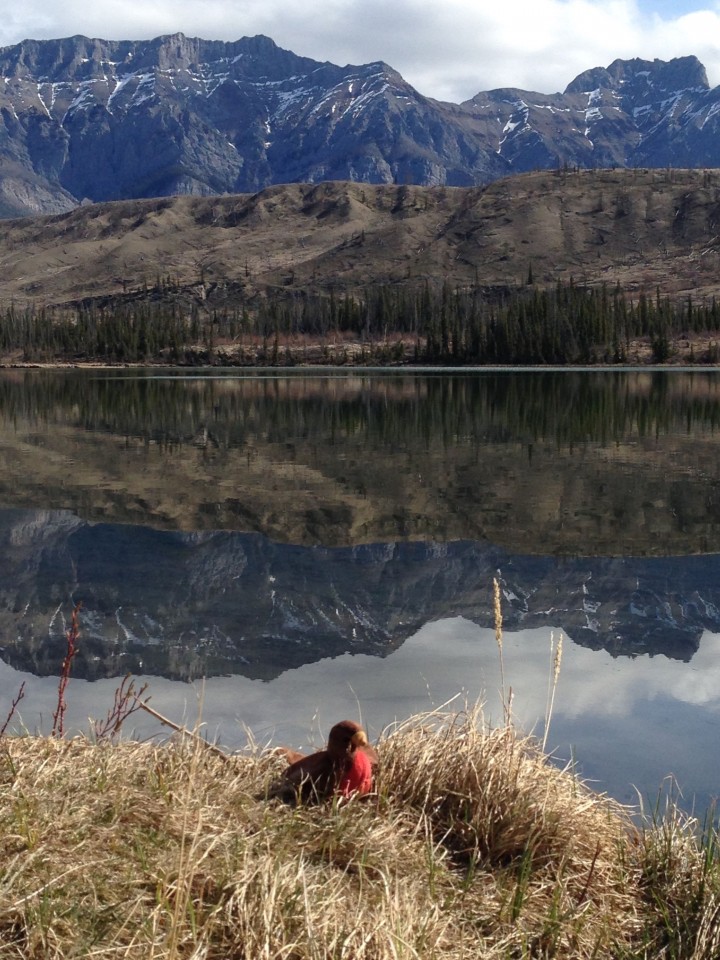
Chirpy taking a rest on the shores of a lake near Jasper, AB. Photo credit: Natalie Boelman.
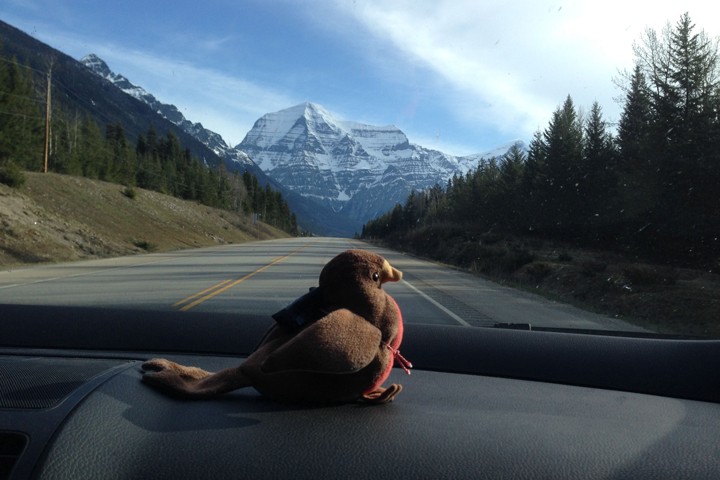
Chirpy in the car with Mt. Robson, British Columbia, Canada in the background. Photo credit: Natalie Boelman.
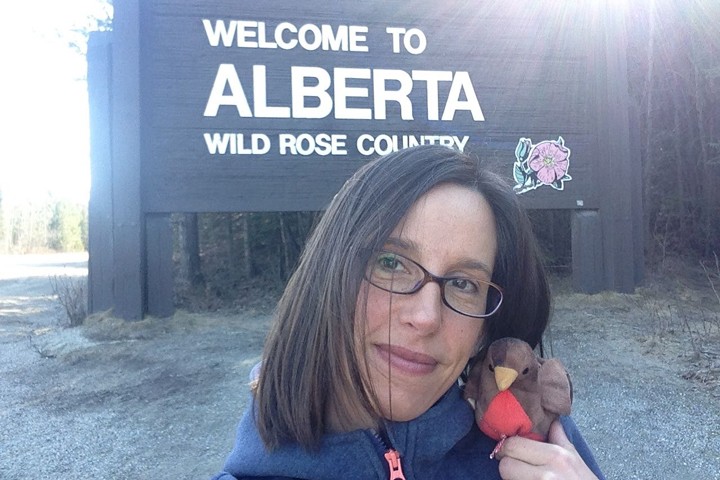
As Chirpy and I were posing in front of the Welcome to Alberta sign, some people in a car stopped and said they thought he was a real bird! Photo credit: Natalie Boelman.
Check out our field site & meet our team!
On Thursday evening around 8:30 pm, we arrived at our field site in the boreal forest, where we will catch and tag 30 American robins over the next week to ten days. We are working and collaborating with scientists at the Lesser Slave Lake Bird Observatory (LSLBO) and the Boreal Centre for Bird Conservation, which are located just north of the town of Slave Lake, Alberta.
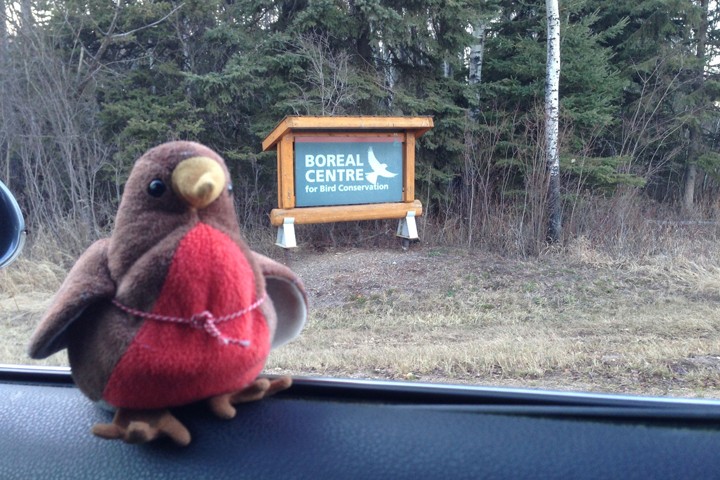
Chirpy arriving at the Boreal Center for Bird Conservation (BCBC).
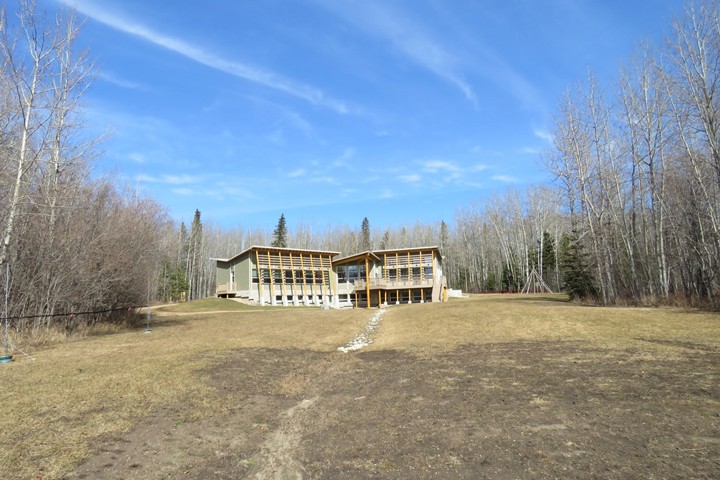
The Boreal Center for Bird Conservation (BCBC).
And, here’s a photo of our team. My Dad and I are on the far left. Willem is my super-handy Dad who has come along for the adventure and to help us with whatever we need help with – thanks Dad! Next to me are Ruthie and Brian, who are both graduate students at Columbia University in New York. Ruthie is working towards her PhD in Earth and Environmental Sciences at the Lamont-Doherty Earth Observatory, and Brian is working towards his PhD in Ecology, Evolution and Environmental Biology. Nicole – our resident bird banding expert – is on the far right. Nicole is a bird biologist who has been working at the LSLBO for almost ten years. She knows a whole lot about the birds here, and how best to catch them!
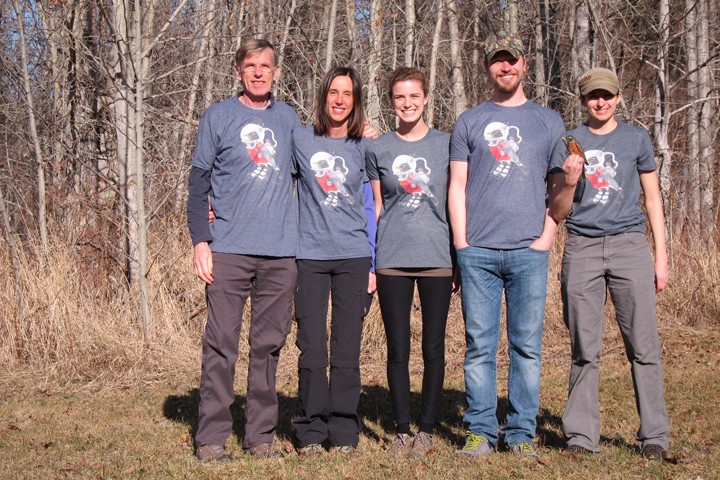
Check out our team T-shirts! Nicole drew this ‘space robin’ and we all liked him so much that we got some fun t-shirts made with him on it. If you looked through the set of slides I posted on the first blog post, you might be able to guess why Nicole drew the robin wearing a NASA astronaut’s space suit. Any guesses?
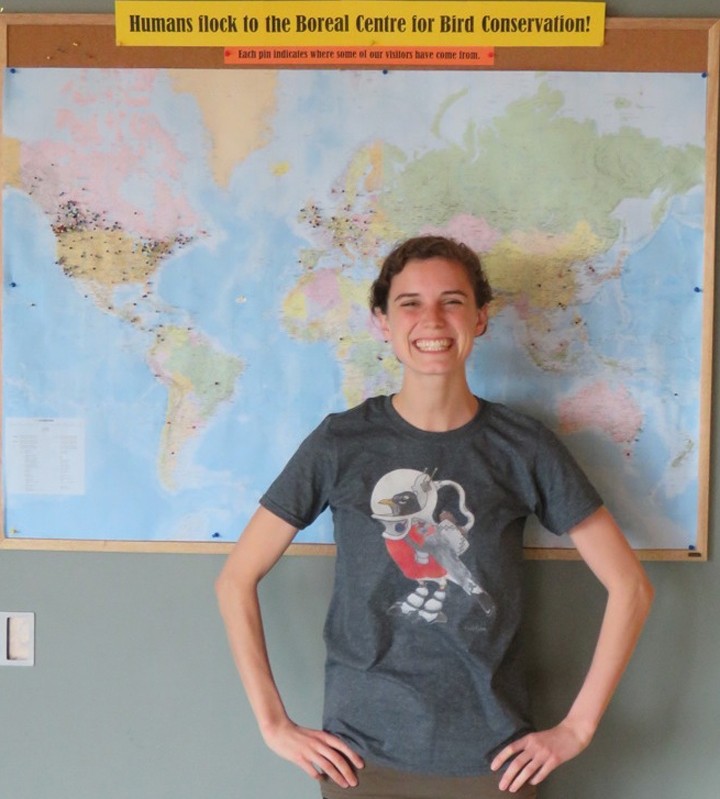
Ruthie modeling our Space Robin t-shirts.
If you haven’t already figured it out, the robin is wearing a space suit because we are using information collected from satellites in outer space that are looking down at the Earth with special sets of ‘eyes‘ that we call sensors. From these satellite sensors, we will learn about two main things:
First, some of the satellites – the GPS satellites – tell us exactly where the robins are as they are migrating. We’ll call these the ‘bird location satellites’. You can learn more about them here.
Second, other satellites tell us about the habitats the robins are using or avoiding as they migrate – like, if there is still snow on the ground, or if they are spending time in a forest or a grassland, if the plants around them are very dry or sitting in big puddles of water, or if there is a forest fire burning. We’ll call these the ‘bird habitat satellites’. You can learn more about them here.
In addition, a third set of satellites will actually be used to transfer the information on where the birds are, from the bird, to me and my team once we’re back in New York. We’ll call these the ‘information transfer satellites’. You can learn more about them here.
Who knew that robins and satellites could work so well together?!
How to catch a robin
The first thing we did after getting a good night’s sleep was to make a plan for how to catch 30 American robins. I’d assumed that we’d be using the ‘playback technique’ where you play recordings of singing robins on one side of a mist net in the hopes that a curious bird hanging out on the other side of the net will fly into as she or he flies over to check out whose singing in their territory. I was familiar with this technique from my work on another project in Alaska, but Nicole had another idea that she thinks will work better to catch the robins migrating through our field site.
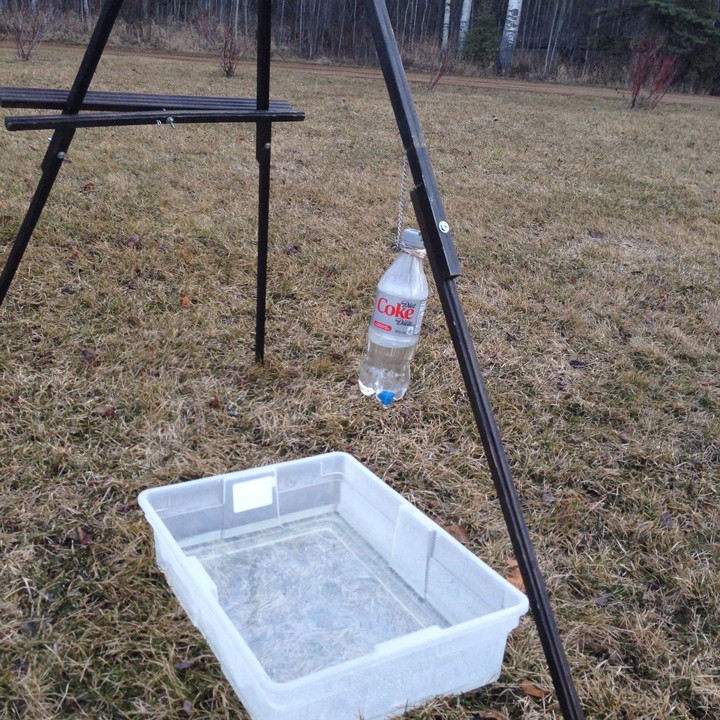
Bird bath with drip to attract migrating robins who are typically thirsty and looking for a place to bathe.
Nicole told us that the birds will be attracted to a bird bath because migrating robins are both thirsty and like to keep clean by bathing, but there’s not a lot of water available to the birds at this time of year because the nearby lake is still frozen and it hasn’t rained enough to create many puddles. So we filled up a big plastic box with water (this is the bird bath), and put it in a nearby field. Then, we got an empty soda bottle, cut a little tiny hole in the bottom, and stuffed a small piece of blue sponge in it. Next we filled up the soda bottle with water and hung it upside down over the bath, so that drops of water would fall from the sponge – kind of like a shower. When the drops of water from the bottle hit the bath water, they make a ‘drip drip drip’ sound that Nicole thinks will attract thirsty robins! We also put up four mist nets in a box shape around the bird bath so that any potential bathers would fly into a net on their way to/from the bath. Genius! Here is a photo of the bird bath and net setup.
While we waited for robins to notice the bird bath and hopefully get stuck in our nets, we went inside to get ready for the first bird that we hoped to catch. Ruthie and I worked on testing the mini-GPS tags (made by Lotek wireless), making sure they were fully charged, and programming them to work once they’re attached to a bird. Brian and Nicole worked on making the harnesses that the mini-GPS tags will be attached to, and my Dad went on a hunt for more harness material.
Not much time went by before our first American robin flew into a net, although it wasn’t one of the bird bath nets, it was a net that the LSLBO’s Bander in Charge (Richard Krikun) had set up about 2 km away for his own study. Thanks for sharing Richard!
Meet our first space robin: Trail Blazer
Meet ‘Trail Blazer’ – our first volunteer space robin! Isn’t he cute?

Ruthie showing her excitement over catching our first space robin, who we named Trail Blazer. Photo credit: Natalie Boelman.
Here is a video and a picture that show how Trail Blazer was caught, how he was weighed, and then equipped with a harness and mini-GPS tag.
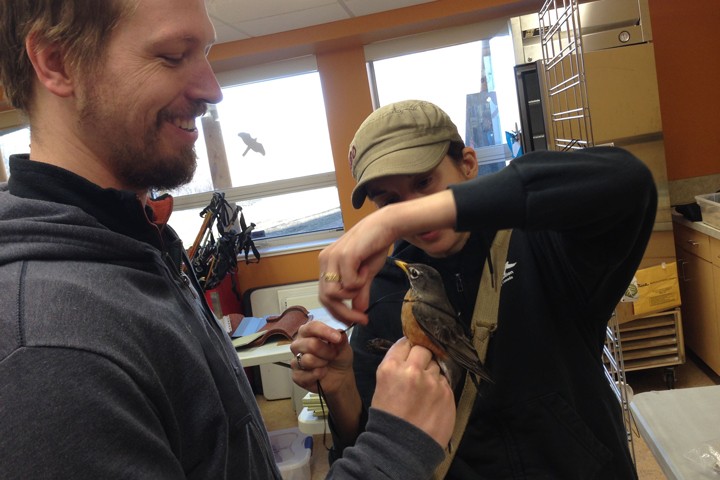
Nicole and Brian are suiting up Trail Blazer with a mini-GPS unit and harness. Photo credit: Natalie Boelman.
Once we were sure the harness and tag were secure and not bothering him, we took Trail Blazer outside and released him. He seemed to fly just fine with his new gear on, and perched for a while in a tree to do some feather rearranging. We hung out near him for about an hour to make sure that he was okay. Eventually he flew off confidently, presumably continuing his migration northwards.

Trail Blazer perching on a branch, showing off his GPS unit and harness. Shortly after this photo was taken, he flew off, presumably continuing his migration northwards. Photo credit: Brian Weeks.
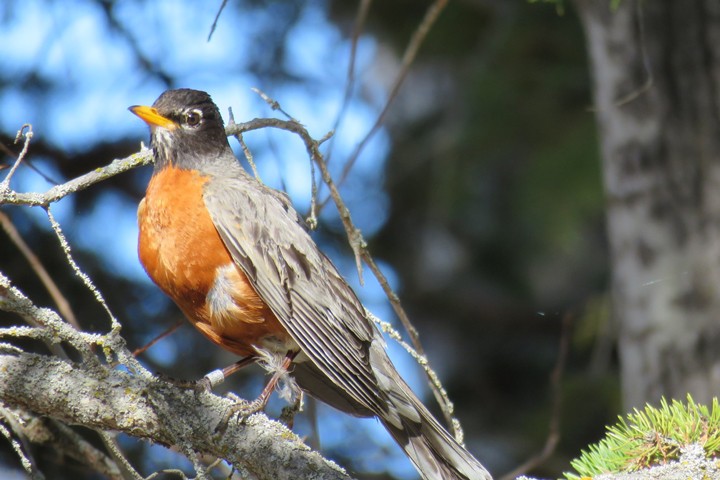
Another view of Trail Blazer. You can barely tell he is wearing his harness and mini-GPS unit. The little white band on his right ankle has a number on it that will help bird biologists recognize him in the future. Photo credit: Brian Weeks.
Safe travels Trail Blazer!
Where is Trail Blazer migrating to and where will he start his family?
We won’t know the answer to these questions for another two months from now because the mini-GPS tag that Trail Blazer is wearing will only send information on where he’s been to the ‘information transfer satellites’ once, in mid-June. Not only did we program his mini-GPS tag to collect information on where he decides to start his family, but also to collect information on the migration route he’ll take to get there! We programmed Trail Blazer’s tag to record his location every two days from the day we caught him (today) until about June 15 when his mini-GPS tag will likely run out of battery power. It’s a long time to be patient and wait to find out where he goes. While we’re waiting, we’ve got 29 more American robins to catch and outfit with tags, so we’ll have plenty to do to keep us distracted for a little while.
Check back here in a few days for more pictures, videos and space robin introductions!
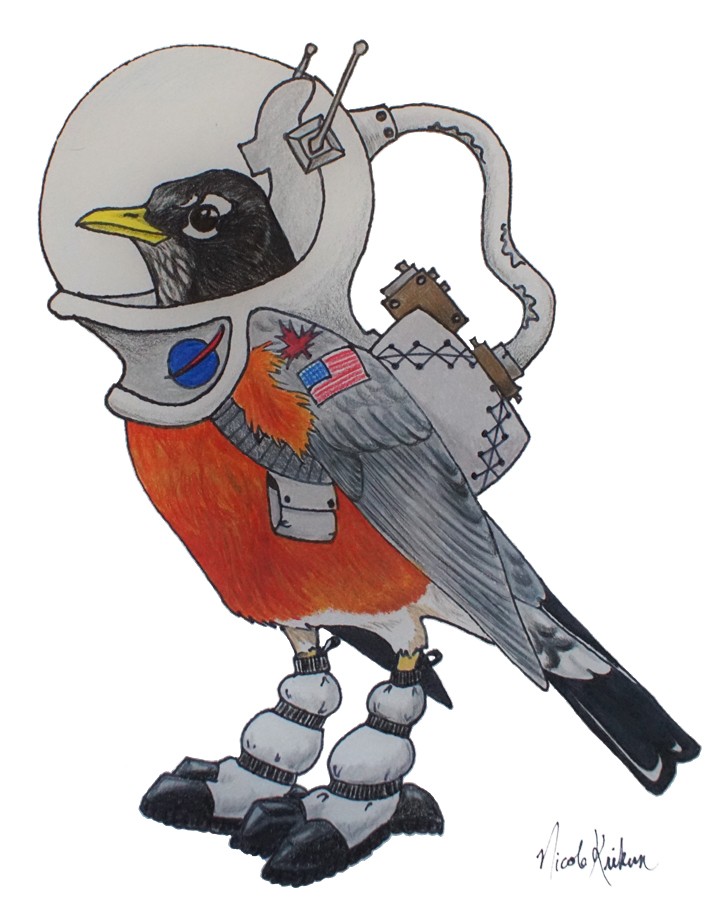
Space robin by Nicole Krikun.
Tags: ABoVE, Canada, Earth Expeditions, Migration Mystery, Robins, wildlife




How sweet!
And what a brave fellow, enduring it for the sake of science!
(but who am I kidding, he’ll find a nice girl robin in no time with those rad new accessoires of him!)*
I’d love to know, though, if that “shower” setup was working and what possibilities there are to follow up the bird biologist work (maybe in a similar blog-ish way?) in general and master Trail Blazers way in particular 🙂
Kind Regards!
S.
* kudos to the R&D of Lotek, must’ve been one hell of an engineering process to get it so small and stable!
What animals have you seen since you have been there? Are there any which you try to avoid?
Hi Mrs. Murphy’s Class,
Yes! We’ve seen animals, but nothing to be scared of.
Here’s the list of what we’ve seen so far:
MAMMALS:
coyote
red tree squirrel
white tailed deer
lots of beaver dams and lodges, but have yet to see a beaver
AMPHIBIANS:
unidentified frog species
BIRDS:
american robin
juncos
white capped chickadee
boreal chickadee
northern harrier
raven
american crow
sharp-shinned hawk
canadian goose
mallard
bufflehead
common golden eye
eastern phoebe
white breasted nuthatch
bald eagle
pileated woodpecker
ruffed grouse
myrtle warbler
bonaparte’s gull
tundra swan
I wanted to know how many robins have you caught currently?
As of Tuesday we’d successfully put GPS backpacks on 2 robins, but just wait for news of more of our robin friends in blog post #3!
It is so cool how you catch the robins! I didn’t know you can use the bird bath to attract the robins. Do the robins go to the bird bath because they hear the “drip, drip” of the water?
That’s what we’re hoping! Turns out robins like to stay clean even while traveling.
wow, that is so fascinating, the fact that your team can get the GPS on the birds without hurting them. I can’t wait to see our bird (Big Mac).
Check back tomorrow for more news!
I think it is cool how you can put a GPS on that small of a bird! Since they are so small do you ever worry you are going to hurt them when you are putting the GPS on the bird? Also, has there ever been a animal trying to eat the American Robin while you were catching it?
Great question! We weigh each robin to make sure they are strong enough to carry a GPS and are very careful when handling them. So far we’re the only ones we’ve seen looking to catch robins.
Wow! I never thought you could catch a bird with a bird bath! I think Nicole was really smart to think of that. But how would you catch the bird after it was in the bird bath? Would you catch it with a net? I also love the pictures you took! The mountains were so pretty and I love the picture of the American Robin in the tree.
What are the predators of the robins? Do the robins eat only bugs?
I also really miss Chirpy.
I miss him too
Bigger birds (like owls and hawks), coyotes, and raccoons all like to eat robins. Robins like to eat all sorts of bugs but they also eat plenty of fruit and some times green vegetation.
Thanks for loaning Chirpie to us, he’s made plenty of friends and been a huge help!
I liked the video with the bird with the bird you caught ❗ SO cool that you can research the robins so closely ❗ 😎 🙂 😯 😆
😎 🙂 😯 😆
Clever idea of using two techniques catching the robins using a birdbath ,and catching the robins using nets ,so you can catch more robins. I adore your picture of the robin in his space suit, good job Nicole. Keep up the good work Dr. Boleman!
Have any birds escaped in your handling and have any of the robins you’ve caught died?
🙁 🙁 🙁 🙁 🙁 🙁 🙁 🙁 🙁 🙁 🙁 🙁
Nope!
Wow! It’s a great that you don’t hurt the robins when catching them. I wonder whether the bird bath makes it easier to catch the robins than playing bird songs.
It is very cool that you have caught a robin.It must have been painstaking waiting for a robin to get caught.Are there any other ways to catch the robins?
P.S. We are from Ms.Christie-Blick’s class.Have you caught Big Mac
Wow i liked how you chached a bird with a net and puting a GPS on that was cool!
Has a bird ever escaped while you were trying to tag it? If so, how many?
Nope, none have gotten away while we were outfitting them with backpacks, but some do manage to get out of the net before we get to them– tricky robins!
Its really cool how you guys are making mini GPS’s for the robins because you guys can track them but the bird has it like a mini backpack to carry. Also its a good idea to make it small because then the bird can hold the GPS.
Actually they buy them online
yes that is true
How does a satellite track so many birds? Does it ever lose track? 🙂 😉
Great question! We actually have many location satellites helping us out. There are many satellites orbiting the earth, so whenever a GPS tag on the back of the birds tries to find its location it talks to whichever satellite is closest. Since we have so many satellites helping us they work together like a team, so we’re not worried about them losing track.
Oh! now I get it thank you! 😉 😉 😉 😉 😉 🙂 !
Nice, How it possible?. wow, that is so fascinating. I really appreciate for your logic. Thanks for sharing with us.